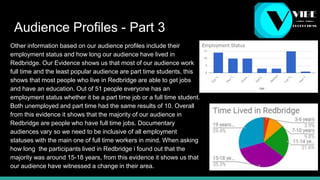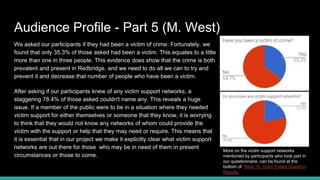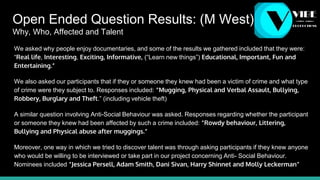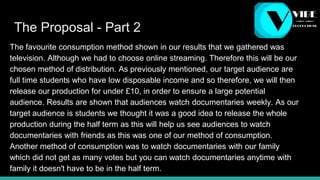Questionnaire results
- 1. Questionnaire Results - Primary Research Units 4, 5, 24 & 31 Millie West, Nikon Ahamed, Lauren Rosenfeld, Benjamin Karrass & Benjamin Goldstone
- 2. Purpose of Research The questionnaire has been conducted to carry out primary research into audiences to find out their opinions and preferences, so that our final product can satisfy their needs.We went out to the local areas of Redbridge and asked people to complete our questionnaire with several questions involved, such as what their favourite documentaries were. We then collected all the opinions and collated them into pie charts and bar graphs so that we can cater our social action project to the specific requirements of the audience. This presentation shows all the collected datas through the questionnaire which has been chosen as a method of primary research as it is one of the easiest way to collect primary quantitative data that can be worked into graph which are visually easier to figure out and calculate. This research shows what our target audience in Redbridge is, as well as what they might not like and how much time they spend and money on watching documentaries.
- 3. Methods and Techniques We have decided to create a questionnaire mainly as it involves the gathering of quantitative data, which means that information and statistics that we will get will be quick and easy to analyse and collect. A questionnaire also gave us the possibility to target different potential audiences which may be interested on what we will be producing as we found different type of people from different ages to still show an interest in what our documentary will be about. The questionnaire also, as said before will allow us to interact better with the audience directly and in addition to that, doing this type of research means that we’ve gathered primary data that is reliable, up to date and less time consuming compared to other type of research therefore we have been efficient both time and money wise.
- 4. Audience Profiles (age - gender) Our results show that our main target audience should include viewers that range from an age of 16 to 35 who are going to have a balanced mix of males and females and this might be the case due to the fact that teenagers and young adults get enjoyment from watching them. They also might be more interested in this type of media product as they tend to have disposable income that they can spend which gives them a wider range of things they may be able to watch.
- 5. Audience Profiles - Part 2 We also asked potential audiences what town in Redbridge they lived in and their ethnicity. Out of 51 people, who partook in the questionnaire, the majority of people were from either Barkingside or Hainault, at 20.8% each. The second most popular towns were Clayhall and Ilford, at 14.6% each. This shows us that we should be focusing our social action project mainly at Barkingside and Hainault, and slightly towards Clayhall and Ilford areas, as audiences are all around Redbridge and we need to be inclusive of them. Another question asked was what ethnicity people were. The majority of people were White British at 52%, second most common was Black British at 18%, and followed by Asian British at 14%. This tells us that we need to be diverse in our video, with different actors and people to interview, in order to appeal to more people.
- 6. Audience Profiles - Part 3 Other information based on our audience profiles include their employment status and how long our audience have lived in Redbridge. Our Evidence shows us that most of our audience work full time and the least popular audience are part time students, this shows that most people who live in Redbridge are able to get jobs and have an education. Out of 51 people everyone has an employment status whether it be a part time job or a full time student. Both unemployed and part time had the same results of 10. Overall from this evidence it shows that the majority of our audience in Redbridge are people who have full time jobs. Documentary audiences vary so we need to be inclusive of all employment statuses with the main one of full time workers in mind. When asking how long the participants lived in Redbridge i found out that the majority was around 15-18 years, from this evidence it shows us that our audience have witnessed a change in their area.
- 7. Audience Profiles - Part 4 Another question asked to the public was if they feel safe within the borough of Redbridge. The results were split almost evenly, with 47.1% saying “No”, and 52.9% saying “Yes”. Therefore, through our social action project, we can learn why people don't feel safe in the borough, and tackle the reasons so that people feel safer. For instance, we can set up crime watches, and persuade more people to volunteer to help out the community. With these new ideas in place, we can make the local area a safer place and make the locals feel safer.
- 8. Audience Profile - Part 5 (M. West) We asked our participants if they had been a victim of crime. Fortunately, we found that only 35.3% of those asked had been a victim. This equates to a little more than one in three people. This evidence does show that the crime is both prevalent and present in Redbridge, and we need to do all we can to try and prevent it and decrease that number of people who have been a victim. After asking if our participants knew of any victim support networks, a staggering 78.4% of those asked couldn't name any. This reveals a huge issue. If a member of the public were to be in a situation where they needed victim support for either themselves or someone that they know, it is worrying to think that they would not know any networks of whom could provide the victim with the support or help that they may need or require. This means that it is essential that in our project we make it explicitly clear what victim support networks are out there for those who may be in need of them in present circumstances or those to come. More on the victim support networks mentioned by participants who took part in our questionnaire, can be found at the bottom of Slide 15: Open Ended Question Results:
- 9. Media Consumption Habits - Part 1 Based on our results, our target audience who likes documentaries tends to watch them weekly or monthly, which suggests that our target audience does not have as much time to spend on watching documentaries and that it may be a hobby used as a time killer more than a passion. Also there are very few people who watch documentaries daily and this may be due to the fact that getting to know a lot of information from these type of programmes can get overwhelming meaning it may be more suitable to watch them less often so that more information can be gathered and remembered.
- 10. Media Consumption Habits - Part 2 Also based on our questionnaire, our audience likes watching documentaries alone and this may be due to the fact that they can consume the information better if they are not being distracted by friends or other people around them when watching. The second most chosen option is with a family and this may be because some of them feel like documentaries are a good opportunity to reunite with the family at some point in the day. Especially as documentaries are created to entertain by giving key information on nature or else based on the topic which can reach out and involve many different people from different ages. This also allowed us to see who the secondary audience was who watch documentaries. 31 people consume their documentaries alone but 2nd was with family with 11 people. This shows us that when watching documentaries there isn't a wide secondary audience.
- 11. Media Consumption Habits - Part 3 Documentaries are consumed in many ways, including watching them on TV or on a DVD. The majority of the people we questioned answered TV as their favourite way to consume a documentary, with 22 people out of 50 watching their documentaries on TV. The least popular way of consumption was DVD, with only 1 person watching their documentaries on them. This shows us for our project we might broadcast it on TV as a wider audience would view our project. Quite a lot of people consume documentaries by online streaming as they can access it easy just as watching it on TV.
- 12. Personal Preferences - Part 1 Audiences were also asked what their favourite documentary programmes were from a list of five, these were BBC Panorama, Channel 4 Dispatches, ITV Exposure, ITV Investigator and Channel 5 Undercover. The majority of people at 44.2% stated BBC Panorama as their favourite, Channel 4 Dispatches as their second favourite at 21.2% and audiences third favourite was ITV investigator with 17.3%. Therefore, with this information, we will watch several programmes of Panorama and Dispatches as these were audience's favourites, and take features of them to put into our own project.
- 13. Personal Preferences - Part 2 In a documentary there are many ways people enjoy watching it, this may include the storyline or the sound and music used. From our questionnaire results it shows us that the majority of people we asked enjoy the storyline of a documentary with 31 people. The least enjoyable part of a documentary according to our stats is sound and music with only 3. We also asked people what would their ideal length of a documentary be, our results show that most people do enjoy watching documentaries that are an hour or longer, 24 people prefer this but both 30 minutes and 15 minutes or less got a similar result of 15 and 12. These results show that when we create our project we should aim to make it lengthy, however we will also stick to our brief and make it around 10 minutes long.
- 14. Open Ended Question Results: (M West) Why, Who, Affected and Talent We asked why people enjoy documentaries, and some of the results we gathered included that they were: “Real life, Interesting, Exciting, Informative, (“Learn new things”) Educational, Important, Fun and Entertaining.” We also asked our participants that if they or someone they knew had been a victim of crime and what type of crime were they subject to. Responses included: “Mugging, Physical and Verbal Assault, Bullying, Robbery, Burglary and Theft.” (including vehicle theft) A similar question involving Anti-Social Behaviour was asked. Responses regarding whether the participant or someone they knew had been affected by such a crime included: “Rowdy behaviour, Littering, Bullying and Physical abuse after muggings.” Moreover, one way in which we tried to discover talent was through asking participants if they knew anyone who would be willing to be interviewed or take part in our project concerning Anti- Social Behaviour. Nominees included “Jessica Persell, Adam Smith, Dani Sivan, Harry Shinnet and Molly Leckerman”
- 15. Open Ended Question Results: (M West) Tackling Crime, Crime Responses, Victim Support Networks We asked the public what ideas they had to tackling crime. The answers they gave included: “Increasing the amount of education, regarding crime, from a young age, including; specialised school programmes (including the consequences of crime); CCTV in crime hotspots; Increase the number of police on the streets; Teach people to become more proactive and not be bystanders; Encourage people to report crime.” Moreover, other responses included “Increasing security; Encouraging people to use non-violent language; Treat people the way that they should be treated and equally as well as use harsher punishments on crimes committed.” It was also suggested that there could be an increase in the amount of funding for youth centres. This can keep youth off of the streets as well as offering them further education outside of the classroom. 20 years ago there were a significantly larger number of youth centres stationed across Redbridge than today. These after school and evening youth centres helped to ensure that youths were off of the street and instead inside in a safe environment, socialising, and doing what kids do! At these times, crime rates were quite low. Over recent years the number of youth centres have gradually decreased. This means that more youths have been on the streets, from the early hours of the afternoon until the late hours of the evening. (These are the times in recent years young society members would have been in youth centres.) As a result of the lack of centres and the increase of people on the street, we have seen a dramatic rise in crime statistics. We asked our participants what they would do if they saw a crime being committed. The responses gathered included: “Call the police; Run away; Take a picture; Take a video; Walk away; Shout or scream; Report it; Contact help; Try and stop it or get involved.” This shows a range of different responses, which could relate to whether people, who live in Redbridge, feel safe or not and how this would transpire into how they would react to witnessing a crime (i.e. whether to walk away and stay silent, report it in silence or get involved). Those who feel more safe may feel more inclined to be proactive, whereas those who do not, may as a result, become a bystander. Finally, we asked if people were aware of any victim support networks. Although there were few confirmations, some of the responses we gathered included: “Police Victim Support, (General) Therapy Groups, Criminal Injury Compensation, victimsupport.com, NIdirect.com and victimsupportservices.org.”
- 16. Conclusion Based on our data gathered, we will be mainly aiming our social action project towards a young audience composed of teenagers and young adults who live in Ilford, Barkingside, Hainault and other areas of Redbridge. Although our primary audience will be teenagers, our secondary audience will be an older audience of 30-40 year olds who are in full time employment. We will also not aim our video towards one specific gender or ethnicity, as several different people are potential victims of crime. Majority of audiences have also lived within Redbridge for more than 15 years, which means we have to do our research on Redbridge in the past to ensure to the audience that we have created a professional production.
- 17. Conclusion Overall, our questionnaire gave us a good insight and advice on what we should do on our project to fit our customer needs and preferences. Therefore, with this information we will tailor our video to suit our target audience, which may increase our chances of success. Creating a product that includes audience needs will allow it to appeal more to our audience. This can include the length of the documentary or the area our documentary is based in. Depending on how long our documentary is, it will allow us to see if it’s short enough to be produced as a short film before a movie in the cinema or as an advent on TV to expand on our audience. As a few people's answers included knowing someone who has been a victim of crime, this tells us that if we create a video about preventing crimes, it can be targeted to a wide audience.
- 18. The Proposal - Part 1 (M West) We propose to create an 8 to 10 minute production, regarding the dramatic increase and rise of crime. Our production does not technically have an age limit because we are trying to target all residents of Redbridge, but we are trying to educate specific groups that may be affected. From our results, as a group, we have concluded that our primary target audience for our production will be 16 to 24-year-olds, specifically males, as they are more likely to be involved in Anti Social Behaviour. Our secondary audience will be 40+ year-olds who will be the parents, guardians, family members or friends of the primary audience. Our production has no age limit as the increase in crime can affect anyone and everyone. We have decided that our chosen topic can be related to by all members of the community, and will be aimed at both genders. This will give us the chance to get the best publicity possible. The larger the audience span, the more chance we have for a large number of people who will hopefully be speaking about it, recommending to and sharing it with other people.
- 19. The Proposal - Part 2 The favourite consumption method shown in our results that we gathered was television. Although we had to choose online streaming. Therefore this will be our chosen method of distribution. As previously mentioned, our target audience are full time students who have low disposable income and so therefore, we will then release our production for under £10, in order to ensure a large potential audience. Results are shown that audiences watch documentaries weekly. As our target audience is students we thought it was a good idea to release the whole production during the half term as this will help us see audiences to watch documentaries with friends as this was one of our method of consumption. Another method of consumption was to watch documentaries with our family which did not get as many votes but you can watch documentaries anytime with family it doesn't have to be in the half term.
- 20. The Proposal - Part 3 The prefered length of documentaries was 30 mins. We found that people prefer watching documentaries that were BBC panorama and channel 4 dispatches. Which means we should include ideas from documentaries on these channels. In our questionnaire one of our questions previously were have you been a victim of crime and we were surprised of how many yes we got which means we will focus mainly on the subject of victim of crime and making sure people get a clear understanding of the importance of crime and how easy it is. We need to make sure that our audience receive a clear understanding of crime as its starting to happen a lot more that it did.



















